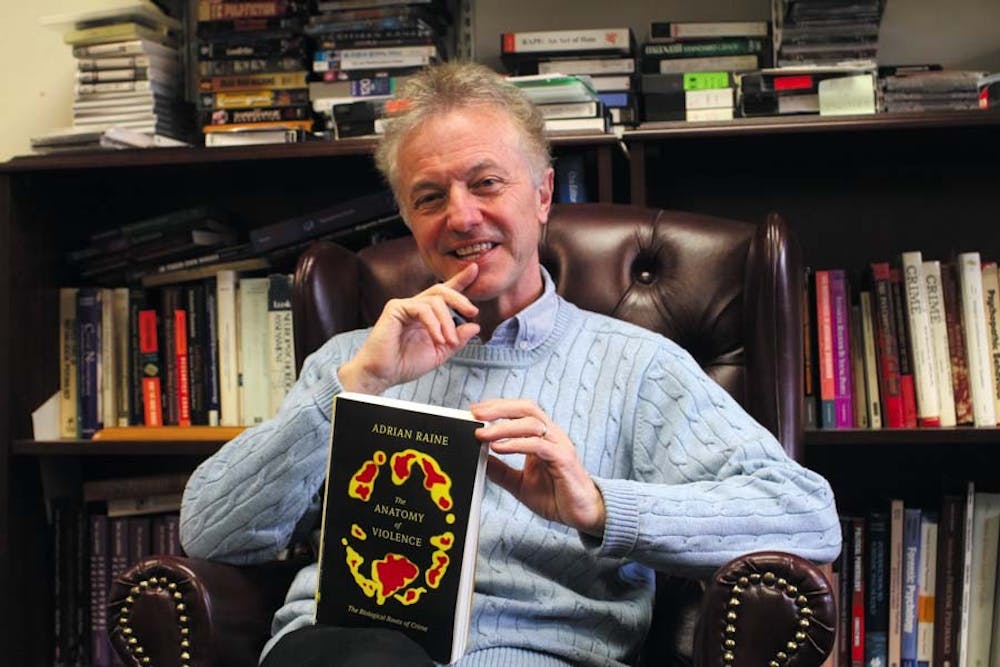
Research a Penn professor has been doing on the brain for the past 35 years is now being considered for a television show.
Adrian Raine is the Richard Perry professor of Criminology & Psychiatry and is set to release his upcoming book, “The Anatomy of Violence: The Biological Roots of Crime,” on April 30. The creators of Showtime’s “Homeland” announced that an adaptation of the book has been approved for pilot production on CBS. The network will decide in May whether to approve the show to become a full series in the fall.
Raine sat down The Daily Pennsylvanian for an interview.
The Daily Pennsylvanian: Why did you write your upcoming book, “The Anatomy of Violence?”
Adrian Raine: I wrote this book because I want to share the knowledge with the public that I share with all of you here at Penn in the classroom. I’ve always been excited by the 35 years of research that I have done, and I wanted to put it into one book in an easy-to-read manner so that everyone has access. It’s for the average lay reader even though there are over 1,000 references to back up what I’m saying. This is the sort of thing that beginning students could read, but it’s also for your mom, your dad, your sister and your brother.
DP: How did this book come to be turned into a CBS television pilot?
AR: It was in August when Howard Gordon [one of the producers of “Homeland”] won several Emmys for “Homeland” — one for writing and several other technical awards. He saw my book, read it and loved it. The book isn’t even out yet, but my agent showed him the book in Los Angeles, and [Gordon] said, “I want to make this the next ‘Homeland.’” He then did a verbal pitch to CBS. Normally what happens at this point is that the people who want to get money for a pilot would write a script and then submit it at the end of December. But I think because Howard was coming off the Emmys, he made a pitch to CBS and they immediately gave four million dollars to him to do a pilot on “The Anatomy of Violence.”
DP: If the show is chosen by CBS for a full season, what role would you play in the series?
AR: I’m a consultant on the pilot, and if it comes to be a full series, I’ll be a consultant on all the episodes. And then the first card before the show starts will say “Based on the book by Adrian Raine.” To me, this is beyond expectation and beyond belief. I will be thrilled from that only because I want people to see the science. If people might see that and say, “Let me go out and read more about this,” my job is done.
DP: Can you give an example of some of the research you have done here at Penn?
AR: We’ve just finished a four year study where we have been studying antisocial and aggressive behavior in 11 and 12 year olds in the community right here around us. The idea here is to use nutrition, a biological component, to change the brain for the better. I’ve done of a lot of brain imaging research showing psychopaths, murders and violent offenders have poor functioning … brains compared with normal people’s. If that’s true and there is a causal connection and bad brains do in fact predispose bad behavior, then the logic can be that if we make the brain better, we can improve behavior.
So we’ve been giving Omega-3 [a long chain fatty acid]to aggressive, antisocial children in our study to see if that supplement can improve the brain to improve behavior. Omega-3 is … critical for brain structure and function, so in theory at least, this could be a very natural and benign biological intervention to help bad children get on the right track. We’ve still got to see if it works, though.
DP: How do you see this research affecting crime prevention in the future?
AR: I don’t know if you saw that Tom Cruise movie “Minority Report,” but that’s really a metaphor for the work and research I do. There’s a perspective here that if we have an individual where the odds of them becoming violent are pretty high, then for a number of reasons, a point in time will come when we make the preemptive strike. We lock the person up before they have the chance to become violent, and that’s something I go into in the last chapter of “The Anatomy of Violence” — when I go into future implications in society.
No, right now we can’t predict which 18-year-olds will be the violent offenders of the future. But having said that, there’s this growing corpus of knowledge now fleshing out the picture on the anatomy of violence documenting the missing pieces that we’ve been missing for so long. We’ve known the social pieces of the jigsaw puzzle, and now we’re uncovering the genetic, hormonal, psychophysiological and brain pieces of the jigsaw puzzle.
I think if we put those pieces together in the next 10 or 20 years, we can see the violent criminal offender for who he is, and once we see him, we will be able to stop him. We will be able to predict who is at risk for violence and hopefully develop benign interventions to better that individual, better their family members and prevent future victims of violence.
The Daily Pennsylvanian is an independent, student-run newspaper. Please consider making a donation to support the coverage that shapes the University. Your generosity ensures a future of strong journalism at Penn.
DonatePlease note All comments are eligible for publication in The Daily Pennsylvanian.








